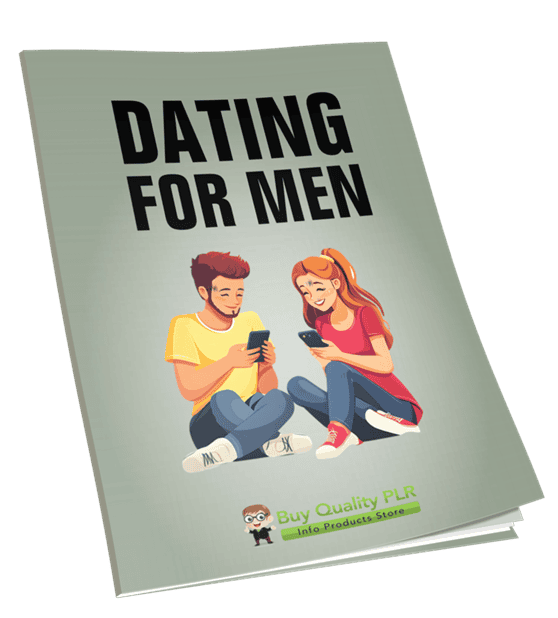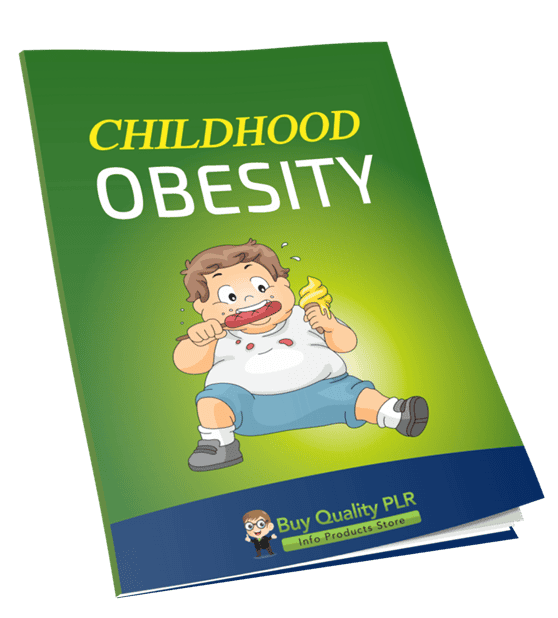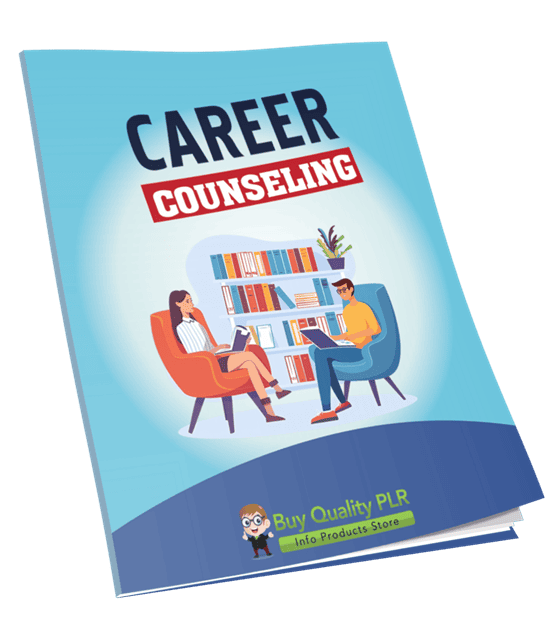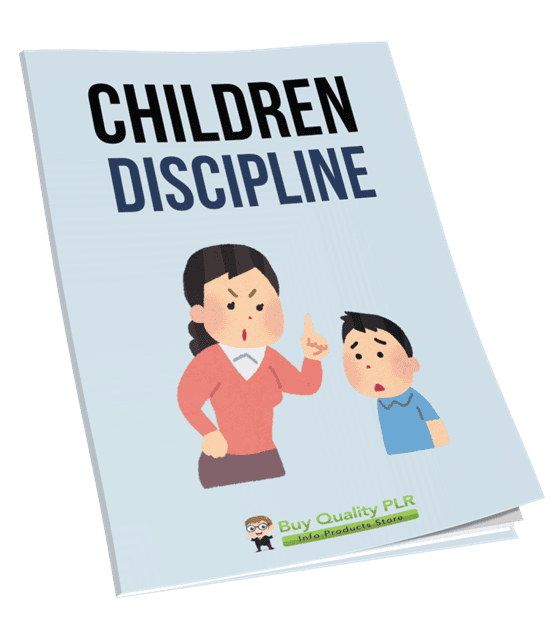
Children Discipline PLR Course 21k Words
in Family PLR Articles , Kids PLR , Kids PLR Ebooks , PLR Checklists , PLR eBooks , PLR eCourses , PLR List Building Reports , Premium PLR , Premium PLR eBooks , Premium PLR Reports , Premium White Label Brandable PLR Coaching Courses , Private Label Rights ProductsChoose Your Desired Option(s)
has been added to your cart!
have been added to your cart!
#childrendiscipline #parentingtips #plrcourse #parentingplr #disciplineguide #childbehavior #parentinghelp #privatelabelrights #plrcontent #parentingstrategies #positivediscipline
Create a Positive, Respectful, and Structured Environment for Effective Discipline
Welcome to the Children Discipline PLR Course! This comprehensive course is designed to guide parents, caregivers, and educators on how to establish positive, respectful, and structured discipline strategies for children. With proven techniques, practical exercises, and valuable insights, this course will empower you to foster healthy behavior in children while maintaining a supportive environment. Let’s embark on this journey to building respectful and responsible kids!
Presenting…
Children Discipline PLR Course 21k Words
What’s Included in the “Children Discipline” PLR Course?
This course includes 19,642 words of high-quality content, designed to provide actionable strategies and techniques for effective discipline. Here’s a detailed breakdown of the course modules:
Module 1: Understanding Discipline – The Foundation
- Step 1: Define Discipline, Not Punishment
- Learn how discipline is about guiding and teaching, rather than punishment.
- Understand how building habits and values is more impactful than enforcing rules.
- Step 2: Know Your Parenting/Teaching Style
- Explore various parenting styles (authoritarian, permissive, authoritative) and how they shape your approach to discipline.
- Reflect on your own style and identify areas for improvement.
- Step 3: The Role of Emotions in Children’s Behavior
- Understand how children express emotions and how emotional intelligence plays a role in discipline.
- Learn how to address the feelings behind behaviors rather than just the behaviors themselves.
- Step 4: Set Clear Values and Expectations
- Establish a clear framework of acceptable behavior that aligns with your core values.
- Learn how to communicate your expectations in a way that children understand.
Module 2: Building Connection Before Correction
- Step 1: Focus on Positive Attention
- Learn how positive reinforcement, such as praise and eye contact, can reduce misbehavior.
- Understand how giving children positive attention helps them feel valued.
- Step 2: Active Listening and Empathy
- Master the art of truly listening to your child, even when they don’t use words.
- Discover how empathy builds cooperation and trust between you and your child.
- Step 3: Create Daily Routines That Support Behavior
- Implement simple tools to create calming, predictable routines that help children feel secure.
- Learn the importance of consistency in daily activities.
- Step 4: Practice Connection Rituals
- Establish 5-minute daily connection rituals, like special one-on-one time, to strengthen the bond with your child.
- Understand how these rituals reduce the need for discipline.
Module 3: Practical Discipline Techniques That Work
- Step 1: Use “When–Then” Statements
- Discover how to use “when-then” statements to redirect behavior and teach responsibility.
- Example: “When you finish your homework, then you can play outside.”
- Step 2: Offer Choices to Encourage Cooperation
- Learn the power of offering limited choices to give children a sense of control while maintaining boundaries.
- Encourage cooperation without exerting authority.
- Step 3: Natural & Logical Consequences
- Use consequences that are directly tied to the behavior to teach children, rather than punish them.
- Learn the difference between natural and logical consequences.
- Step 4: Time-In Instead of Time-Out
- Discover how the “Time-In” method works by staying with your child to help them regulate emotions.
- Teach children to learn from mistakes with empathy and guidance.
Module 4: Staying Calm and Consistent
- Step 1: Create Your Own Calm Plan
- Learn techniques to stay calm and centered in challenging situations (deep breathing, pausing, etc.).
- Develop a plan to handle difficult moments with composure.
- Step 2: Be Consistent with Rules and Follow-Through
- Understand the importance of consistency in discipline.
- Learn how to enforce boundaries in a kind and confident manner.
- Step 3: Use Encouragement Over Praise
- Shift from empty praise to genuine encouragement, focusing on effort and progress.
- Discover the power of encouraging effort: “You worked hard on that!”
- Step 4: Reflect and Adjust, Not React
- Learn the importance of reflection over reaction.
- Cultivate resilience in your child by teaching them to learn from their mistakes.
Module 5: Long-Term Growth – Raising Responsible Kids
- Step 1: Teach Problem Solving, Not Just Obedience
- Guide your child to think through situations and make better choices.
- Foster problem-solving skills alongside obedience.
- Step 2: Encourage Responsibility Through Daily Habits
- Learn how simple routines, such as chores and goal-setting, help build responsibility and self-esteem in children.
- Develop responsibility through everyday tasks.
- Step 3: Model Respectful Communication
- Learn how to model respectful communication to teach kindness, active listening, and boundary-setting.
- Use your own communication style to guide children toward respectful behavior.
- Step 4: Celebrate Progress, Not Perfection
- Focus on tracking growth and celebrating effort, not just achieving perfection.
- Encourage a growth mindset by teaching your child to learn from mistakes and celebrate small wins.
Why Choose the “Children Discipline” PLR Course?
- In-depth Knowledge: This course covers every essential aspect of disciplining children, from setting clear expectations to building long-term responsibility.
- Proven Techniques: Includes practical and tested discipline strategies that can be immediately applied.
- Customizable Content: Easily modify this course to align with your brand’s voice and specific audience needs.
- Educational & Empowering: The course doesn’t just focus on discipline—it also helps you raise emotionally intelligent and respectful children.
How to Profit from the “Children Discipline” PLR Course
This PLR course can be a lucrative asset for your business. Here are several ways to monetize it:
- Sell the Course as a Standalone Product: Offer it on your website or via online learning platforms like Teachable or Thinkific.
- Bundle with Other Products: Combine the course with other PLR products (ebooks, reports) to offer a higher-value package.
- Membership Site: Use this course as part of a paid membership site.
- Webinars/Workshops: Host webinars or live sessions based on the course content and charge for access.
- Offer Coaching or Consulting: Use this course as a foundation to offer one-on-one parenting coaching or group coaching sessions.
License Terms
Permissions:
- Sell the content with minor tweaks to make it “yours.”
- Modify and claim copyright if you change 75% of the content.
- Break up the content into smaller reports or sell as individual units.
- Bundle the course with other PLR products for higher-value sales.
- Set up a membership site or sell access to a multiple-week eclass.
- Use the content for physical products, audios, or videos.
- Excerpt and use portions for free as lead magnets.
Restrictions:
- You may not pass on resell rights to your customers.
- No 100% affiliate commissions allowed.
- No distribution of complete materials for free; only excerpted or edited content can be given away.
Get Started Today!
Don’t wait to start improving your discipline strategies and raise emotionally intelligent children! By purchasing the Children Discipline PLR course, you’ll be equipped with practical tools, strategies, and methods to create a positive environment for growth and respect.
Start your journey today and create a more disciplined and respectful environment at home!
Buy Now and Transform Your Parenting with Effective Discipline Strategies!
has been added to your cart!
have been added to your cart!
Here A Sample of Children Discipline PLR Course
Goal: To help you build a positive, respectful, and structured environment where children learn good behavior naturally.
Module 1: Understanding Discipline – The Foundation
Let’s start with the basics – understanding what discipline really is and why it matters.
Step 1: Define Discipline, Not Punishment
Module 1: Understanding Discipline – The Foundation
Audience: International course creators, parenting coaches, educators, and caregivers
Objective of This Step
To provide a clear, globally-understood definition of discipline and differentiate it from punishment. This step lays the foundation for a values-based approach to raising and educating children that is rooted in respect, guidance, and long-term character building.
Training Instructions and Description
1. Start With a Clear Definition of Discipline
Begin your lesson by defining what “discipline” means in the context of child development. Use simple, universal language that learners from diverse cultures can understand.
Key Definition:
Discipline is the practice of guiding children toward appropriate behavior, helping them learn self-control, responsibility, and respect for others. It is proactive, educational, and relationship-based.
Clarify that discipline is about teaching and learning, not about control or fear. It involves setting boundaries, modeling behavior, and helping children make better decisions over time.
Use this example to demonstrate:
- Discipline: “You’re having a hard time sharing your toy. Let’s try taking turns. I’ll help you.”
- Punishment: “If you don’t share right now, you’re going to time-out!”
This contrast helps learners see that discipline invites collaboration and correction, while punishment typically imposes suffering.
2. Clarify the Difference Between Discipline and Punishment
Create a visual or written comparison chart with two columns labeled “Discipline” and “Punishment.”
| Aspect | Discipline | Punishment |
| Purpose | To teach and guide | To penalize and control |
| Approach | Respectful and solution-focused | Reactive and fear-based |
| Long-Term Effect | Builds responsibility and self-regulation | Often leads to resentment or shame |
| Emotional Tone | Calm, connected, consistent | Angry, authoritative, or dismissive |
| Tools Used | Natural consequences, choices, redirection | Yelling, threats, physical or emotional harm |
Encourage learners to reflect on the difference. Ask them to consider:
- Which approach aligns with your values as a parent, educator, or coach?
- Which method prepares children to make wise decisions independently?
3. Discuss the Historical Shift in Parenting and Education
Explain how discipline has evolved across cultures and generations. This is important for international course creators who may be working with learners from countries with different disciplinary norms.
Key discussion points:
- Traditional models often equated discipline with punishment, especially physical or authoritarian styles.
- Modern child psychology now encourages positive discipline, which aligns with global human rights standards and child development research.
- The shift emphasizes dignity, communication, and emotional intelligence.
Present examples from countries or regions:
- In Scandinavian countries, physical punishment is illegal and positive discipline is promoted in schools.
- In some Asian cultures, obedience is valued, but there’s a growing movement toward emotional coaching.
- The United Nations Convention on the Rights of the Child supports non-violent discipline methods.
Make it clear that positive discipline is not about being permissive—it is about being firm and kind at the same time.
4. Provide Real-Life Scenarios for Comparison
Break learners into pairs or small groups (if applicable in your course platform) and ask them to work through real-life scenarios. Each scenario should be approached in two ways: as punishment and as discipline.
Scenario Example:
- A child refuses to do their homework.
Punishment Approach:
“You’re grounded for a week. No games until you finish everything.”
Discipline Approach:
“It seems like you’re struggling to get started. Let’s figure out what’s hard about it and come up with a plan. We’ll take breaks and use a timer to stay focused.”
Ask learners:
- Which response teaches a skill?
- Which response preserves the relationship?
- What message does each send to the child?
Encourage learners to journal their reflections or record a short video explaining how they would apply discipline in their own context.
5. Reframe Misbehavior as a Learning Opportunity
Teach participants to view misbehavior not as a personal offense but as a signal—a message that a child needs help learning a new skill or expressing an emotion.
Three Key Questions to Ask:
- What is the child trying to communicate?
- What skill is the child missing?
- How can I teach or model this skill through discipline?
This mindset shift helps course creators frame discipline as a compassionate and educational act. Emphasize that children thrive in environments where mistakes are met with teaching rather than shame.
6. Provide a Takeaway Tool: The “Discipline Mindset Guide”
End the lesson by offering a printable or digital takeaway that course creators can pass on to their learners. The guide should include:
- A definition of discipline
- A checklist for responding to misbehavior in a respectful way
- A sample discipline vs. punishment chart
- Key phrases to use with children
- Encouraging affirmations for caregivers (e.g., “I guide, I don’t punish”)
This tool reinforces the mindset and provides something tangible they can integrate into their course content or coaching practice.
7. Wrap-Up Summary
Close this step with a reflection:
“Discipline isn’t about control—it’s about coaching. Children don’t need to be scared into good behavior; they need to be shown how through patient, consistent guidance. As course creators, you have the opportunity to model and teach this powerful shift across cultures, homes, and classrooms.”
We’re also giving these extra bonuses
Children Discipline – Checklist
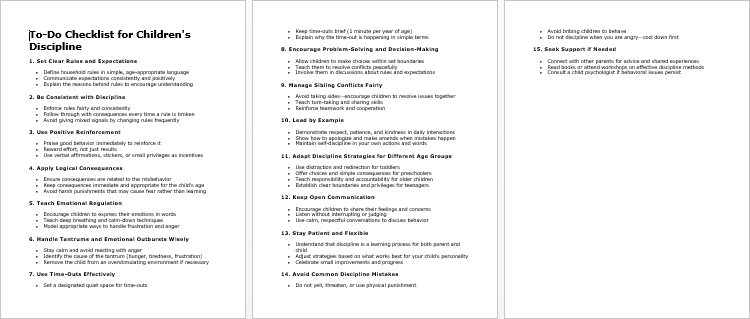
Children Discipline – FAQs

Children Discipline – Salespage Content
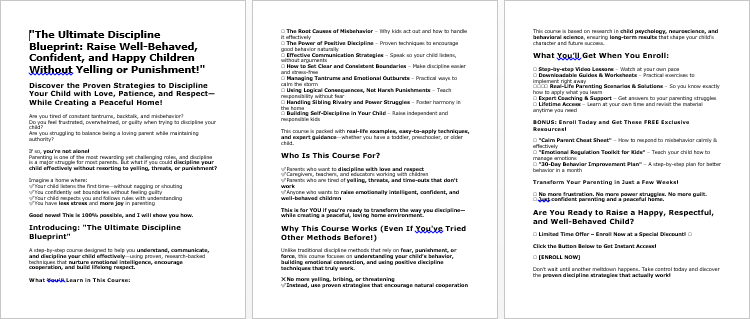
Package Details:
Word Count: 19 642 Words
Number of Pages: 113
Children Discipline – Bonus Content
Checklist
Word Count: 432 words
FAQs
Word Count: 988 words
Salespage Content
Word Count: 664 words
Total Word Count: 21 706 Words
Your PLR License Terms
PERMISSIONS: What Can You Do With These Materials?
Sell the content basically as it is (with some minor tweaks to make it “yours”).
If you are going to claim copyright to anything created with this content, then you must substantially change at 75% of the content to distinguish yourself from other licensees.
Break up the content into small portions to sell as individual reports for $10-$20 each.
Bundle the content with other existing content to create larger products for $47-$97 each.
Setup your own membership site with the content and generate monthly residual payments!
Take the content and convert it into a multiple-week “eclass” that you charge $297-$497 to access!
Use the content to create a “physical” product that you sell for premium prices!
Convert it to audios, videos, membership site content and more.
Excerpt and / or edit portions of the content to give away for free as blog posts, reports, etc. to use as lead magnets, incentives and more!
Create your own original product from it, set it up at a site and “flip” the site for megabucks!
RESTRICTIONS: What Can’t You Do With These Materials?
To protect the value of these products, you may not pass on the rights to your customers. This means that your customers may not have PLR rights or reprint / resell rights passed on to them.
You may not pass on any kind of licensing (PLR, reprint / resell, etc.) to ANY offer created from ANY PORTION OF this content that would allow additional people to sell or give away any portion of the content contained in this package.
You may not offer 100% commission to affiliates selling your version / copy of this product. The maximum affiliate commission you may pay out for offers created that include parts of this content is 75%.
You are not permitted to give the complete materials away in their current state for free – they must be sold. They must be excerpted and / or edited to be given away, unless otherwise noted. Example: You ARE permitted to excerpt portions of content for blog posts, lead magnets, etc.
You may not add this content to any part of an existing customer order that would not require them to make an additional purchase. (IE You cannot add it to a package, membership site, etc. that customers have ALREADY paid for.)
Share Now!


